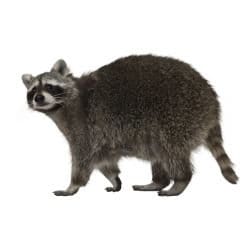Raccoon

Identification
Most commonly, raccoons have grayish-brown fur with black highlights around their face and tail.
Raccoons measure about 2-3 feet long from the nose to the tip of the tail.
Raccoons are known for their characteristic black mask around their eyes and striped tail. They have a stocky build with short legs and sharp claws, making them excellent climbers.
Get A Free Quote
We are affordable Pest Control Service in GTA & Surroundings Areas.
Physical Characteristics
Raccoons are known for their distinctive physical characteristics. These creatures have a unique appearance with their black-ringed tails and bandit-like facial markings. Their fur is thick, soft, and grayish-brown in colour, which helps them keep warm during the colder months. Raccoons also have sharp claws on their front paws that make them efficient climbers.
Apart from this, raccoons are well-known for their dexterous hands, allowing them to manipulate objects easily. They have five fingers on each hand, just like humans but with sharper nails to grab and hold onto things tightly. Additionally, these critters possess excellent night vision because of the reflective layer behind their retina, known as tapetum lucidum, helping them to see even when it’s dark outside.
It is worth noting that raccoons come in different sizes depending on where they live: urban or rural areas. But their shape resembles a Rabbit. Urban raccoons are larger because they have access to more food than those living in the wild. In contrast, rural raccoons are typically smaller due to the limited resources available in the natural habitats such as forests or fields where they normally live.
Raccoons Behaviour
Raccoons are known for their naughty behaviour, often getting into trash cans and causing a mess. However, this behaviour is not just limited to scavenging for food. They have also been observed playing with objects such as balls and toys, exhibiting traits of curiosity and intelligence.
Studies have shown that raccoons can adapt their behaviour based on their environment. In urban areas, they have learned to cross roads safely by looking both ways before crossing. Raccoons also exhibit social behaviour, living in family groups or “bands” consisting of a mother and her offspring.
Despite their cute appearance, it is important to remember that raccoons are still wild animals and can exhibit aggressive behaviour if they feel threatened or cornered. It is important to give them space and avoid feeding them as it can lead to dependency on humans for food, leading to further problematic behaviours in the future.
Raccoons Habitat
Raccoons, medium-sized nocturnal mammals, are known for their distinct black mask around their eyes and ringed tails. These creatures are native to North America but have become adaptable to living in urban areas as well. Their habitat is usually near water sources like rivers or streams, where they can easily find food and shelter.
Raccoons are omnivores and eat almost anything from insects to fruits and vegetables, which makes them versatile scavengers. They prefer denning in hollow trees or abandoned burrows but have also made attics, chimneys, and crawl spaces of homes their habitat. This adaptability has led to an increase in raccoon populations in urban areas.
Although raccoons may seem cute and harmless, they can transmit diseases like rabies through bites or scratches. It is important to avoid approaching or feeding them as it can encourage their presence near human dwellings leading to conflicts with humans and property damage. Proper management of garbage disposal and securing potential entry points of homes can help prevent the intrusion of these animals into human habitats while allowing them the space they need to thrive in their natural habitats.
Diet
Raccoons are notorious for being scavengers and opportunistic eaters. Their diet varies incredibly, ranging from fruits and vegetables to small animals such as rodents, birds, and insects. They have even been known to scavenge through human trash cans for food.
One interesting aspect of raccoon diets is that they have a high tolerance for toxins found in some foods like acorns. In fact, they will often seek out these types of foods during the fall when other food sources may be scarce. However, it’s important to note that while raccoons can tolerate certain toxins in their diets, humans should always take caution when handling or consuming any wild animal or plant.
Overall, while the diet of raccoons may seem haphazard and random at times, it’s clear that these creatures have developed a unique ability to adapt to different environments and food sources.
Humane Wildlife Removal Service
Acme Pest Solutions offers humane wildlife removal services to ensure the safety and well-being of both animals and humans.
Our team at Acme Pest Solutions is trained to handle a variety of wildlife species and uses eco-friendly and humane methods to ensure the safety of both the animals and the environment.
Importance of Controlling Raccoon Populations
Raccoons are notorious for their scavenging habits and are commonly found in urban areas rummaging through trash cans, gardens, and pet food dishes. While they may seem harmless at first glance, raccoons can cause significant damage to property and pose a threat to human health. They carry diseases such as rabies, leptospirosis, salmonella, and roundworms that can easily spread to humans and other animals.
Controlling the raccoon population is essential for maintaining a safe environment. One way of doing this is by preventing them from accessing food sources such as garbage cans and bird feeders. Homeowners should secure their trash cans with tight-fitting lids or store them in an enclosed area. They should also avoid leaving pet food outside overnight.
Another method of controlling raccoon populations is by trapping them humanely. It’s crucial to note that trapping raccoons without a permit is illegal in most parts of the country. Therefore, it’s best to contact a ACME Pest Solutions that will trap the animals safely and release them into the wild, away from residential areas. By taking these measures, homeowners can prevent property damage caused by raccoons while ensuring public safety from related health risks.
